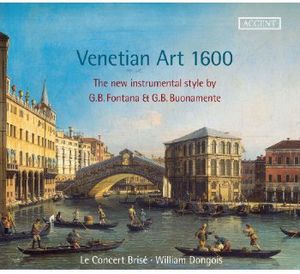Show results for
Deals
- Blu-ray Outlet
- New Release 4K
- New Release Blu-ray
- New Release DVD
- New Release Gifts
- New Release Music
- New Release Vinyl
- Top Seller 4K
- Top Seller Blu ray
- Top Seller DVD
- Top Seller Vinyl
- top sellers all movies
- top sellers all music
- Top Selling Gifts
- TV Outlet
- Top Seller Music
- DVD Outlet
- In Stock Outlet
- Music Outlet

Venetian Art 1600
- Format: CD
- Release Date: 27/11/2012

Venetian Art 1600
- Artist: Le Concert Bris
- Label: Accent Records
- Genre: Classical
- UPC: 4015023242531
Product Notes
Venetian Art 1600 - The New Instrumental Style By Fontana & Buonamente / Dongois, Le Concert Brise, Composer: Giovanni Buonamente, Giovanni Fontana, Conductor: William Dongois, Orchestra/Ensemble: Le Concert Brisé, Number of Discs: 1. The first sonatas composed at the beginning of the seventeenth century reflect the fundamental change that has taken place in vocal music around 1700. Starting out from the Florentine Camerata, the new style of recitar cantando developed, and laid down the foundation for the emergence of opera and madrigal. The appearance of an autonomous instrumental music, which was to become typical in the seventeenth century and which is relatively independent of the vocal models, is one of the consequences of this musical revolution. Two representatives of this generation of composers are Giovanni Battista Fontana and Giovanni Battista Buonamente, and it is no coincidence that both were violinists. The autonomy of the instrumental music goes hand in hand with the growing importance of the violin, which gradually replaced the cornett in sacred music. This music is at the crossroads of all the influences and all the usual musical forms of the time. One can hear recitatives and arias, as well as sections reminiscent of organ toccatas. Accordingly William Dongois and his ensemble Le Concert Brisé have entrusted the melodic parts in their exciting recording of sonatas and dance movements by Fontana and Buonamente to violin and cornett, and it is fascinating to hear how this music characterizes both echoes of the vocal music as well as typically instrumental diminutions and virtuosic passages.


